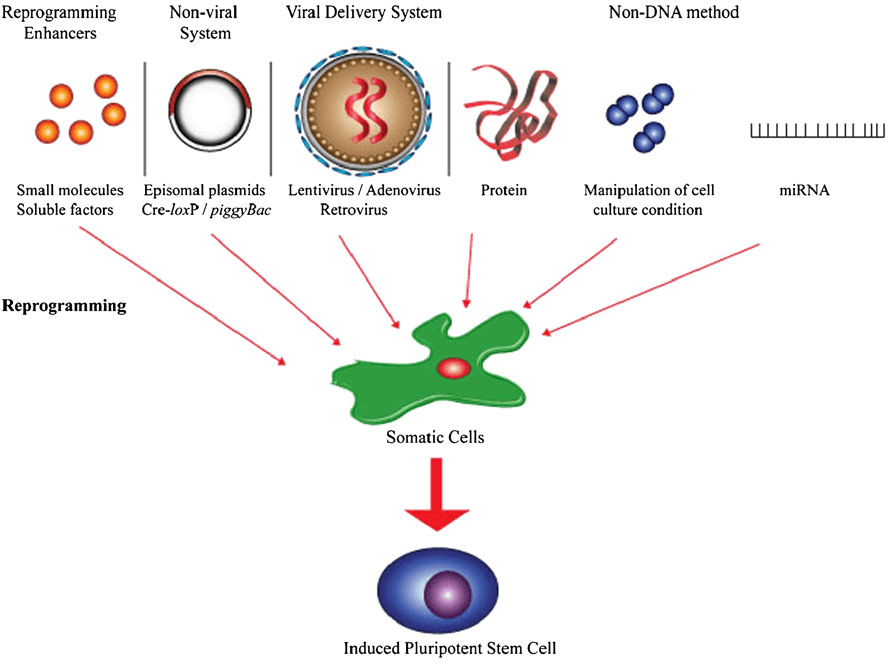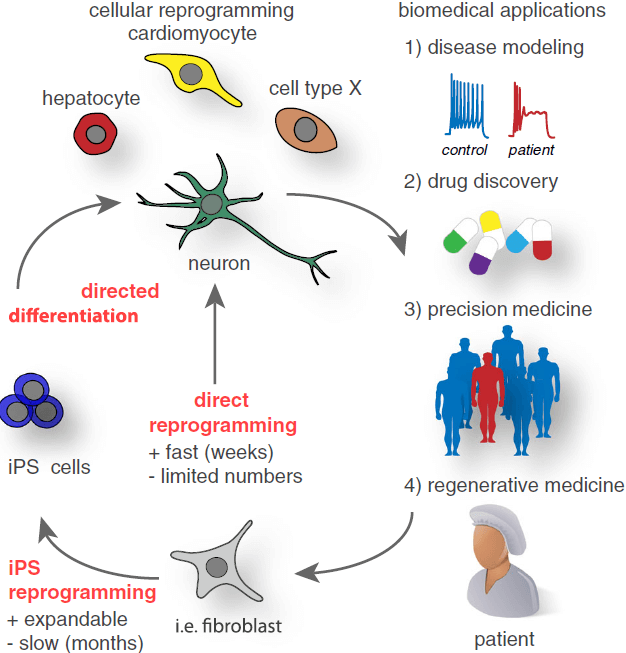Cell Reprogramming Services
Creative Bioarray is committed to provide professional cell reprogramming services with our cutting edge technologies to accelerate your research and drug development.
Introduction of Cell Reprogramming
Cell reprogramming refers to the process of reverting mature, differentiated cells into embryonic-like or pluripotent stem cells under specific conditions. These cells are called induced pluripotent stem cells (iPSCs) and have the potential to further differentiate into various cell types or develop into new individuals. Cell reprogramming also refers to the process of erasing epigenetic memories and re-establishing pluripotency of somatic cells.
The main techniques used for cell reprogramming include transduction of transcription factors, cell fusion, in vitro culture, nuclear transfer and introduction of egg extract. They are feasible for reprogramming and epigenetic research. The variables that may affect cell reprogramming include the choice of initial cell type, the selection of reprogramming factors, culture conditions, and delivery method. By using various small molecules and growth factors, or manipulating cellular environment, reprogrammed iPSCs can be guided to different differentiation pathways.

Figure 1. The current reprogramming strategies used to induce pluripotent stem cells from adult somatic cells. (Lai M I, et al., 2011)
iPSCs have become important tools to help us understand how cells develop, what goes wrong inside cells, and how diseases occur. Ethical concerns related to embryonic stem cells can be eliminated in iPSCs. This allows scientists to establish disease models to discover and test new drugs to treat or prevent diseases, such as Parkinson’s and Alzheimer’s.
Cell reprogramming offers multiple opportunities in clinical applications, from wound healing to the treatment of complex diseases. Cell reprogramming has great potential in new medical applications, such as cell replacement therapy and tissue engineering. In the future, iPSCs might provide unlimited replacement cells and tissues for patients with currently untreatable diseases.

Figure 2. Current cellular reprogramming technologies and future biomedical applications. (Mall M, & Wernig M., 2017)
Our Cell Reprogramming Services
We can provide different cell reprogramming methods for different cell types and purposes. The reprogrammed cells will undergo fully identification and well cryopreservation.
Genetic Cell Reprogramming
Multiple transcription factors have been identified to be capable of reprogramming somatic cells into pluripotent cells. Rapid development of gene manipulation techniques, such as virus vectors, episomal plasmid vectors, piggyBac transposon, mRNA and miRNA-based reprogramming, protein-based approaches, and CRISPR technology, can be used to deliver a defined cocktail of reprogramming factors or facilitate genome editing.
Cell Fusion-Induced Reprogramming
Cell fusion is a useful cell reprogramming technique. Somatic cells can be reprogrammed to a pluripotential state by fusing with pluripotent cells. Chemical modification, virus mediated and electroshock are frequently used methods. Cell fusion is an efficient method and important tool to study the mechanism of reprogramming.
Chemical Reprogramming
Several chemical compounds, such as CHIR99021, can direct reprogram one somatic cell type into another desired cell type, such as glial cells, neuronal cells, and cardiomyocytes. This virus-free and oncogene-free method, which has little effect on genomic integrity and cell functions, is ideal to further reduce the risk for tumorigenesis.
Creative Bioarray can provide customized cell reprogramming services with fast turnaround time and competitive price. We can also carry out follow-up experiments at your request. Specialty media for cell reprogramming can also be customized in Creative Bioarray.
If you need more detailed information, please feel free to contact us. We look forward to cooperating with you.
References:
- Lai M I, et al. Advancements in reprogramming strategies for the generation of induced pluripotent stem cells. Journal of assisted reproduction and genetics, 2011, 28(4), pp: 291-301.
- Mall M, & Wernig M. The novel tool of cell reprogramming for applications in molecular medicine. Journal of Molecular Medicine, 2017, 95(7), pp: 695-703.
For research use only. Not for any other purpose.



